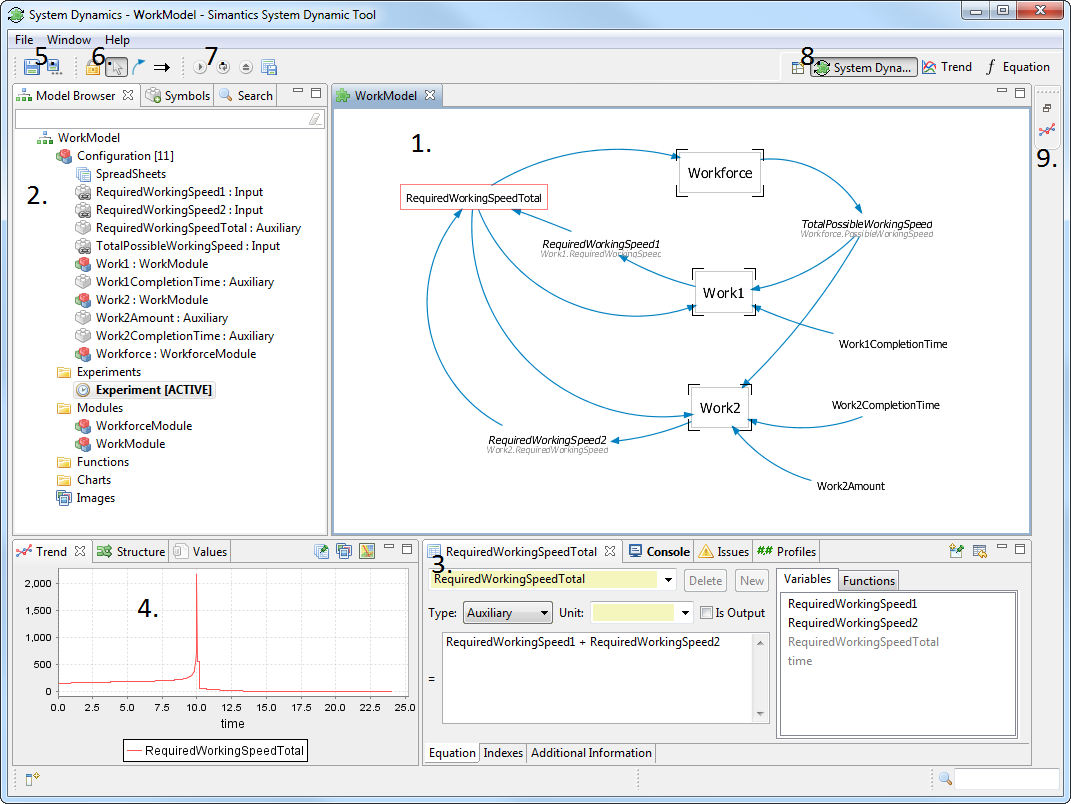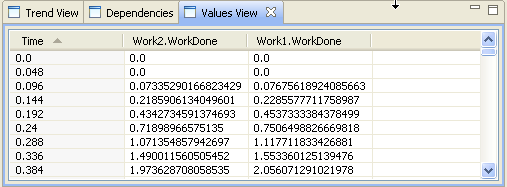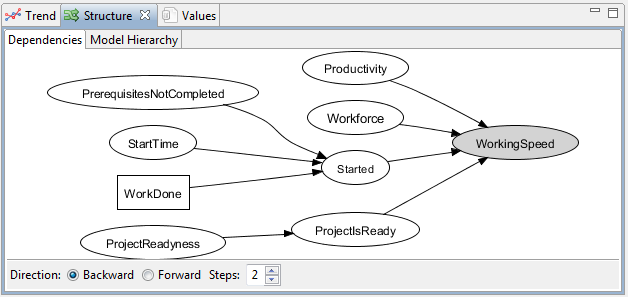Simantics System Dynamics: Difference between revisions
No edit summary |
No edit summary |
||
| Line 4: | Line 4: | ||
The history and basic uses | The history and basic uses | ||
=== | ===Model=== | ||
Model structure as seen in the model browser. | |||
[[File:ModelStructure.png|left]] | |||
: Model consists of five main collections: Operating interfaces, Images, Configuration, Experiments and Modules. They all contain | |||
<br style="clear: both" /> | |||
===Components=== | |||
[[File:ComponentTypes.png|left]] | |||
Basic components of a model: Auxiliary, valve, stock, cloud, input, module | Basic components of a model: Auxiliary, valve, stock, cloud, input, module | ||
Connections: Dependencies, Flows | Connections: Dependencies, Flows | ||
<br style="clear: both" /> | |||
===Modeling principles=== | ===Modeling principles=== | ||
Revision as of 12:08, 22 September 2010
Introduction to System Dynamics Simulation
System Dynamics
The history and basic uses
Model
Model structure as seen in the model browser.
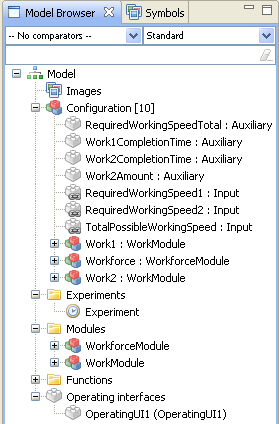
- Model consists of five main collections: Operating interfaces, Images, Configuration, Experiments and Modules. They all contain
Components
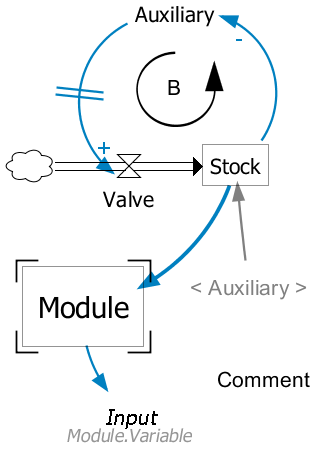
Basic components of a model: Auxiliary, valve, stock, cloud, input, module Connections: Dependencies, Flows
Modeling principles
What kind of models should be created, good practicies
System Dynamics Workbench
Install / Use
How to install and start the program. What is required (Modelica, VC90)
Layout
- Diagram
Diagram is the area where you will graphically modify your model. Diagrams are built from elements that can be dragged from Symbols view or populated using shortcut keys. - Model Browser
Model browser shows the structure of your model and all items related to it.
Symbols view is behind the model browser and used for dragging elements to diagrams. - Equation
Equation view shows the selected variable's properties. Equation view has a different layout depending on the type of the selected variable. The view can also have different tabs depending on the variable type. Basic tabs are Equation and Additional information. - Trend
Trend view shows the graphical representation of the values of the selected value over time. For the trend to be shown, a simulation has to be run. The view shows always the results of the latest run, but you can save results of a simulation and show them in the same trend with results from another simulation. Values view and Dependencies are located at the same place and can also be used for analyzing the model. - Experiment controls
Experiment controls are shown when an experiment is active. Experiment is activated by double clicking an experiment in the model browser. With the experiment control, you can start simulation runs and save simulation results.
System Dynamics Modelling
Basic modelling
Basic modelling functions enable you to create and configure models. System dynamics modeling is basically pretty simple, so with these instructions you can build small and also very large models. The tricky part is writing all the expressions and adjusting the model so that it actually tells you something.
- Creating a new model
- Start a new model by right-clicking the model browser and selecting New->Model or from the main menu File->New Model.
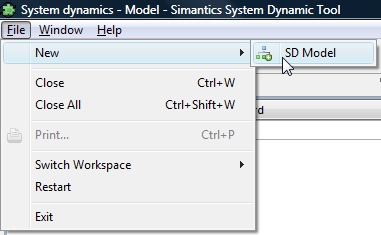
- Creating a new module type
- Create a new module type by right-clicking on the Modules-folder and selecting New->Module. This creates a new module type that you can populate to your other modules and the model configuration.
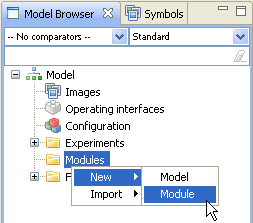
- Configuring a model
- Model configuration can be opened by double clicking Configuration in the model browser.
- Configuring modules
- Configuration of a module type can be opened by double clicking the module type you want to configure. You can also open the configuration of a module from a diagram, when a module has been populated to that diagram, by right-clicking the module and selecting Show Module. When opening modules from diagram, the opened diagram knows to which diagram the module has been populated and can show the connections between the modules. Keep in mind that when making changes to a module, the changes apply to all instances of the module!
- Populate variables
- You can drag variables to a diagram from symbol view. You can also populate variables using shortcut keys
- Populate modules
- Modules are populated from the model browser. Just drag the module you want to populate from the Modules folder to a diagram.
- Create connections
- There are two types of connections: dependencies and flows. Both are created basically the same way. Hold Alt down and click on a variable. Left click starts a dependency, right click starts a flow. Both are ended to another variable with a left click.
- Flows can also be started and ended to an empty spot in the diagram. If there is no start or end variable, a cloud will be created. Also if start or end is not a valve, a new valve is created in the middle of the flow.
- There are some restrictions on what connections can be made, but don't worry, the user interface won't let you do connections that are not allowed.
- Connections between modules
- Outside the module
- You can connect variables to variables in modules like this:
MODULE -----> INPUT or ANY VARIABLE -----> MODULE
- This is just the visual configuration, but you need those connections to really connect variables in the module's properties.
- In Inputs -tab you select which variables you connect to inputs inside the module. In Outputs -tab you select which variables you lift from the module to inputs outside it.
- Inside the module
- Input variables get values from outside the module
- Output variables can send their values outside the module. From the variable properties, select Additional Information and press Is Output
- Configure variables
- Select a single variable from diagram or model browser. The properties of the variables are shown in the equation view and you can modify them.
- Export model
- To export your model to a file, select your model from the model browser, right-click and from the context menu choose Export... Select the folder where to export your model, give the file a name and press Save. You do not need to export a model to Save it, the model is automatically saved in your database. Export can be used to for example create different versions of the model, create backups or to transport it to another database.
- Import model
- Right-click on the model browser and select Import... Browse to your .tg file and select open. The model is added to your model browser.
Operating User Interfaces
- Create
- Right-click on Operating interfaces and select New->Operating UI. Open the Operating User Interface by double clicking it.
- Configure
- Operating UIs have their own set of widgets. Widget symbols can be seen in the Symbols view and dragged to the diagram. The properties of the widgets can be modified from the properties view (same as equation view).
- To connect a variable to a widget, just drag it from the model browser to the widget.
- You can use monitors as labels, but to change the text on the monitor, you have to switch to operating mode by clicking
 .
.
- Use
- To use the interface you have created, you have to switch to operating mode by clicking
 . Activate a simulation, run it and the trends will show the results. You can switch values of parameters with the widgets and simulate again.
. Activate a simulation, run it and the trends will show the results. You can switch values of parameters with the widgets and simulate again.
Shortcut and control keys
Shortcut keys for configuring a model on diagram.
| Shift + A | Hover Auxiliary at the cursor position, populate with left mouse button. |
| Shift + S | Hover Stock at the cursor position, populate with left mouse button. |
| Shift + C | Hover Cloud at the cursor position, populate with left mouse button. |
| Shift + V | Hover Valve at the cursor position, populate with left mouse button. |
| Shift + I | Hover Input at the cursor position, populate with left mouse button. |
| Alt + left mouse button | Start an arrow from a variable. End to another variable by clicking left mouse button. |
| Alt + right mouse button | Start flow from a variable. End by clicking left mouse button.
If a flow is not started or ended on to a variable, a cloud will be created to that end. |
| Delete | Remove selected variables |
| Ctrl + left mouse button | Select multiple variables |
| Mouse wheel or + and - |
Diagram zoom |
| drag(mouse3) or drag(shift + any mouse button) |
Diagram pan |
| Ctrl + Z | Undo diagram action |
| Ctrl + Y | Redo diagram action |
| Ctrl + C | Copy selected elements |
| Ctrl + X | Cut selected elements |
| Ctrl + V | Paste copied or cut elements |
System Dynamics Simulation
- Simulate model
- To simulate a model, you need to activate an experiment. Browse to an experiment in you model browser and double click on the experiment. Experiment controls appear to the main tool bar. Click on the play button to run a simulation.
- Analyze results
- There are currently three analysis tools in the system dynamics tool.
- Trend
- Values
- Dependencies
- Compare results
- You can compare different results of the same model by saving simulation results and displaying the saved results side by side with other results. You can save your results after simulating by clicking the save button
 on your experiment controls. The saved results appear to model browser under the active experiment. To show the results on trends and tables, right-click on the result and select Show on charts.
on your experiment controls. The saved results appear to model browser under the active experiment. To show the results on trends and tables, right-click on the result and select Show on charts.
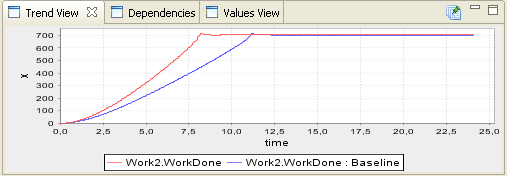
Getting Started with Simantics | Project Management | Discrete Event System Modelling | System Dynamics Modelling | Ontology Development

Tutorial: System Dynamics Modelling
System dynamics modelling in Simantics is another free domain specific modelling tool that is included into the basic installation. This tutorial introduces the basic features of the system dynamcics modelling tools.
